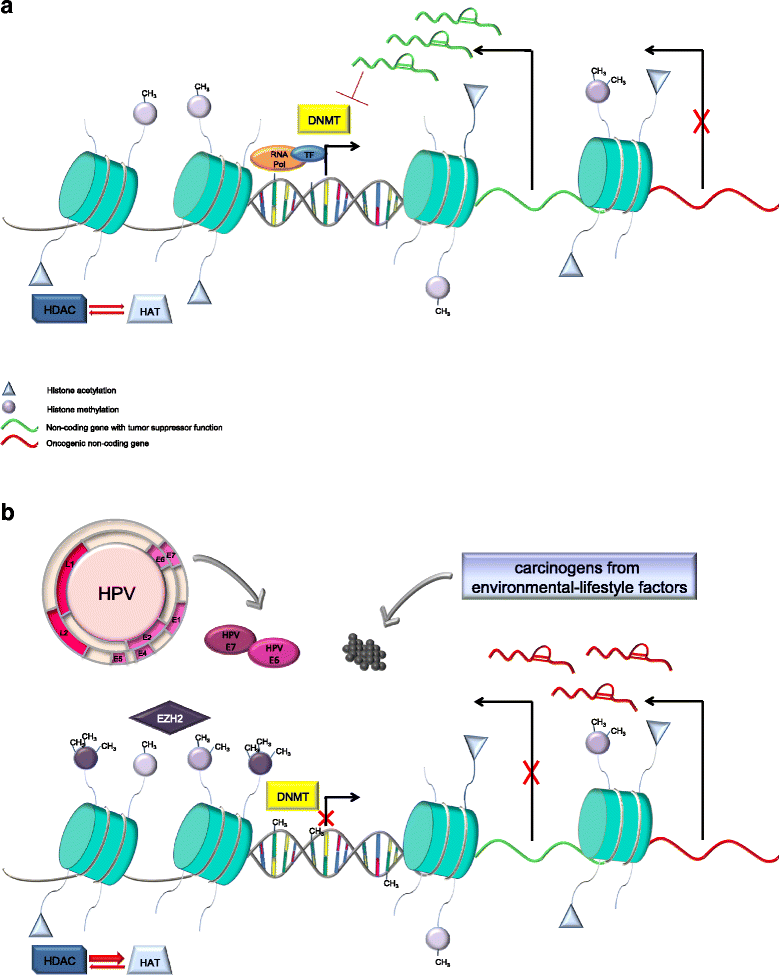Novel insights into epigenetic drivers of oropharyngeal squamous cell carcinoma: role of HPV and lifestyle factors
- PMID: 29209433
- PMCID: PMC5704592
- DOI: 10.1186/s13148-017-0424-5
Novel insights into epigenetic drivers of oropharyngeal squamous cell carcinoma: role of HPV and lifestyle factors
Abstract
In the last years, the explosion of high throughput sequencing technologies has enabled epigenome-wide analyses, allowing a more comprehensive overview of the oropharyngeal squamous cell carcinoma (OPSCC) epigenetic landscape. In this setting, the cellular pathways contributing to the neoplastic phenotype, including cell cycle regulation, cell signaling, DNA repair, and apoptosis have been demonstrated to be potential targets of epigenetic alterations in OPSCC. Of note, it has becoming increasingly clear that HPV infection and OPSCC lifestyle risk factors differently drive the epigenetic machinery in cancer cells. Epigenetic changes, including DNA methylation, histone modifications, and non-coding RNA expression, can be used as powerful and reliable tools for early diagnosis of OPSCC patients and improve prognostication. Since epigenetic changes are dynamic and reversible, epigenetic enzymes may also represent suitable targets for the development of more effective OPSCC therapeutic strategies. Thus, this review will focus on the main known epigenetic modifications that can occur in OPSCC and their exploitation as potential biomarkers and therapeutic targets. Furthermore, we will address epigenetic alterations to OPSCC risk factors, with a particular focus on HPV infection, tobacco exposure, and heavy alcohol consumption.
Keywords: Environmental risk factors; Epigenetics; Human papillomavirus; Oropharyngeal cancer.
Conflict of interest statement
Ethics approval and consent to participate
Not applicable.
Consent for publication
Not applicable.
Competing interests
The authors declare that they have no competing interests.
Publisher’s Note
Springer Nature remains neutral with regard to jurisdictional claims in published maps and institutional affiliations.
Figures

Similar articles
-
Epigenetic Mechanisms of Human Papillomavirus-Associated Head and Neck Cancer.Arch Pathol Lab Med. 2015 Nov;139(11):1373-8. doi: 10.5858/arpa.2014-0554-RA. Epub 2015 May 15. Arch Pathol Lab Med. 2015. PMID: 25978766 Review.
-
Discovery and development of differentially methylated regions in human papillomavirus-related oropharyngeal squamous cell carcinoma.Int J Cancer. 2018 Nov 15;143(10):2425-2436. doi: 10.1002/ijc.31778. Epub 2018 Sep 21. Int J Cancer. 2018. PMID: 30070359
-
Human papillomavirus DNA and p16 expression in Japanese patients with oropharyngeal squamous cell carcinoma.Cancer Med. 2013 Dec;2(6):933-41. doi: 10.1002/cam4.151. Epub 2013 Oct 27. Cancer Med. 2013. PMID: 24403267 Free PMC article.
-
Molecular subclassification determined by human papillomavirus and epidermal growth factor receptor status is associated with the prognosis of oropharyngeal squamous cell carcinoma.Hum Pathol. 2016 Apr;50:51-61. doi: 10.1016/j.humpath.2015.11.001. Epub 2015 Nov 17. Hum Pathol. 2016. PMID: 26997438
-
[Human papillomavirus and squamous cell cancer of the head and neck region : Prognostic, therapeutic and prophylactic implications].HNO. 2016 Jul;64(7):450-9. doi: 10.1007/s00106-016-0123-0. HNO. 2016. PMID: 26864190 Review. German.
Cited by
-
Role of Virus-Induced Host Cell Epigenetic Changes in Cancer.Int J Mol Sci. 2021 Aug 3;22(15):8346. doi: 10.3390/ijms22158346. Int J Mol Sci. 2021. PMID: 34361112 Free PMC article. Review.
-
PRINS lncRNA Is a New Biomarker Candidate for HPV Infection and Prognosis of Head and Neck Squamous Cell Carcinomas.Diagnostics (Basel). 2020 Sep 28;10(10):762. doi: 10.3390/diagnostics10100762. Diagnostics (Basel). 2020. PMID: 32998396 Free PMC article.
-
Survival‑related DLEU1 is associated with HPV infection status and serves as a biomarker in HPV‑infected cervical cancer.Mol Med Rep. 2022 Mar;25(3):77. doi: 10.3892/mmr.2022.12593. Epub 2022 Jan 11. Mol Med Rep. 2022. PMID: 35014679 Free PMC article.
-
Histone methylation in DNA repair and clinical practice: new findings during the past 5-years.J Cancer. 2018 May 24;9(12):2072-2081. doi: 10.7150/jca.23427. eCollection 2018. J Cancer. 2018. PMID: 29937925 Free PMC article. Review.
-
Targeted Therapy as a Potential De-Escalation Strategy in Locally Advanced HPV-Associated Oropharyngeal Cancer: A Literature Review.Front Oncol. 2021 Aug 17;11:730412. doi: 10.3389/fonc.2021.730412. eCollection 2021. Front Oncol. 2021. PMID: 34490123 Free PMC article. Review.
References
-
- Ferlay J, Steliarova-Foucher E, Lortet-Tieulent J, Rosso S, Coebergh JW, Comber H, Forman D, Bray F. Cancer incidence and mortality patterns in Europe: estimates for 40 countries in 2012. Eur J Cancer. 2013;49(6):1374–1403. - PubMed
-
- Hashibe M, Brennan P, Chuang SC, Boccia S, Castellsague X, Chen C, Curado MP, Dal Maso L, Daudt AW, Fabianova E, et al. Interaction between tobacco and alcohol use and the risk of head and neck cancer: pooled analysis in the International Head and Neck Cancer Epidemiology Consortium. Cancer Epidemiol Biomark Prev. 2009;18(2):541–550. - PMC - PubMed
-
- Hashibe M, Brennan P, Benhamou S, Castellsague X, Chen C, Curado MP, Dal Maso L, Daudt AW, Fabianova E, Fernandez L, et al. Alcohol drinking in never users of tobacco, cigarette smoking in never drinkers, and the risk of head and neck cancer: pooled analysis in the International Head and Neck Cancer Epidemiology Consortium. J Natl Cancer Inst. 2007;99(10):777–789. - PubMed
Publication types
MeSH terms
LinkOut - more resources
Full Text Sources
Other Literature Sources
Medical

